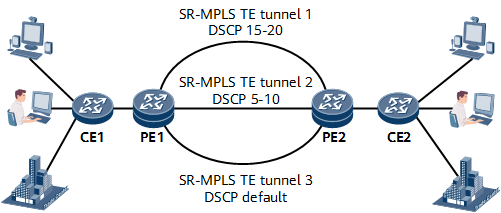DSCP-based Tunneling for IP Packets to Enter SR-MPLS TE Tunnels
Background
Differentiated services code point (DSCP)-based IP packet tunneling is a TE tunnel selection mode. Unlike the traditional TE load-balancing mode, this mode enables services to be forwarded over a specific tunnel based on the service priority, offering higher service quality to higher-priority services.
Existing networks face a challenge that they may fail to provide exclusive high-quality transmission resources for higher-priority services. This is because SR-MPLS TE tunnels are selected based on public network routes or VPN routes, which causes a device to select the same SR-MPLS TE tunnel for services with the same destination address or belonging to the same VPN instance but with different priorities.
A PE that supports DSCP-based IP packet tunneling can divert IP packets to corresponding SR-MPLS TE tunnels based on DSCP values in the packets. Compared with class-of-service-based tunnel selection (CBTS) which supports only eight priorities (BE, AF1, AF2, AF3, AF4, EF, CS6, and CS7) and requires service traffic to be matched against the eight priorities based on a configured multi-field classification policy, DSCP-based IP packet tunneling directly maps IP packets' DSCP values to SR-MPLS TE tunnels and supports more refined priority management (0 to 63), allowing SR-MPLS TE to be more flexibly deployed according to service requirements.
Implementation
The DSCP attribute can be configured for tunnels to which services recurse in order to carry services of one or more priorities. Services with specified priorities can only be transmitted over corresponding tunnels, rather than being load-balanced among all tunnels to which the services may recurse. The default DSCP attribute can also be configured for tunnels to carry services of non-specified priorities.
- DSCP values, for example, 15–20, 5–10, and default, are configured for SR-MPLS TE tunnels.
- According to service characteristics (DSCP values in IP packets), PE1 maps the video services to SR-MPLS TE tunnel 1, voice services to SR-MPLS TE tunnel 2, and Ethernet data services to SR-MPLS TE tunnel 3 that is configured with the default DSCP value.

Configuring the default attribute is not mandatory for tunnels without DSCP values. If the default attribute is not configured, services that do not match the tunnels with specific DSCP attribute values will be transmitted along a tunnel that is assigned no specific DSCP attribute value. If such a tunnel does not exist, these services will be transmitted along a tunnel that is assigned the smallest DSCP attribute value.
Usage Scenario
- SR-MPLS TE tunnel load balancing on the public network, LDP over SR-MPLS TE, or SR-MPLS TE tunnels (non-load balancing) are configured on a PE.
- IP/L3VPN, including IPv4 and IPv6 services, is configured on a PE.
- In the VLL, VPLS, and BGP LSP over SR-MPLS TE scenarios, DSCP-based tunneling for IP packets is not supported.
- This function is not supported on a P.
